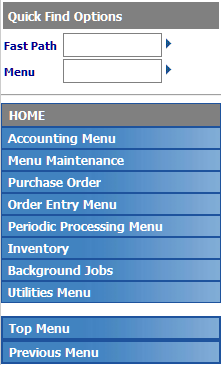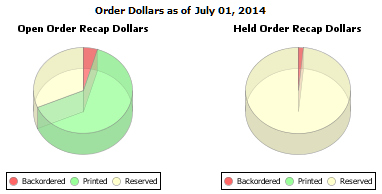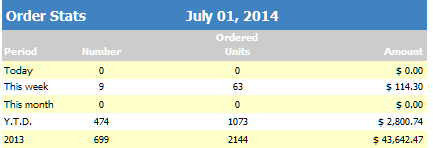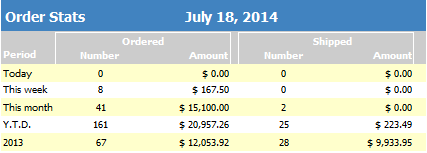
Purpose: You can use any menu in the system to advance to a different menu or a menu option, scan for menus and menu options, display current order statistics, and advance to administrative options.
Some important features of the menu driver include:
• Quick Find Options: Fast Path, Menu selection, and menu advancement
• Link to review or edit your user profile
• Link to log out of CWSerenade
• Announcements
• Charts depicting open and held order dollar totals
• Company logo and default company image
• Order and shipment statistics for the day, week, month, year, and previous year, or a company-specific image for users who do not have authority to view this information
• Calendar enabling you to display order and shipment statistics for different dates
• Standard icons to change companies, advance to administration screens (My Docs, My Jobs, My Forms), or open the online help
• If the current company is not flagged as an Active company, the screen displays a message: This company is flagged as inactive and should not be used to process live orders. See the Create Company Screen for information on setting this flag.
Note: When you sign on to the system, you advance to your default menu. To display the HOME menu (if it is not your default menu, or to return to it from a different menu), enter HOME in the Menu field.
In this topic:
• Calendar
• Open, Held Order Recap Dollars

Purpose: Use the quick find options to advance to a menu option or a menu.

For more information: See Menu Driver Screen for the location of the quick find options, and links to other options available at the Menu Driver screen.
Field |
Description |
Use this field to enter a unique code for a menu option, providing direct access without advancing through the menus. Each option on the system has a Fast Path name. For example, if you enter MITM in the Fast Path field, you advance to Work with Items/SKUs. If you do not know the option name, you can click on the arrow. You advance to the Select Menu Options Window, where you can search and select the desired option. When accessible to the user, the Fast Path and Menu fields can be displayed or hidden by selecting Toggle Fast Path/Menu. The Fast Path setting in the user's record controls whether menus display the Fast Path field. See the User Configuration guide. Alphanumeric, 4 positions; optional. |
|
Use this field to enter a unique menu name to advance it directly without advancing through the menu tree. For example, if you enter INVENTORY in the Menu field, you advance to the Inventory Menu. If you do not know the menu name, you can click on the arrow to advance to the Select Menu Window, where you can search and select the desired menu. The Fast Path setting in the user's record controls whether menus display the Menu field. See the User Configuration guide. Alphanumeric, 10 positions; optional. |
|
The short name of the current menu. Alphanumeric, 10 positions; display-only. |
|
Menu names |
Use the links below the current menu name to advance through the menu tree to select a different menu or a menu option. The description of each menu or menu option assigned to the current menu through the Customizing Menus (WMNU) option is available for selection. For example, the Periodic Processing menu is assigned to the HOME menu. If you select this menu, the menus and menu options assigned to the Periodic Processing menu (such as Work with Periodic Processes) are listed. See Customizing Menus (WMNU) for information on assigning menus and menu options to menus. Menu description: alphanumeric, 20 positions; optional. Menu option description: alphanumeric, 40 positions; optional. |
Top Menu |
Use this option to return to the Default menu from your user profile, as set up though Working with User Records (WUSR). See the User Configuration guide for background. |
Previous Menu |
Use this option to return to the previously displayed menu. |

Purpose: This area of the menu screen displays a greeting consisting of the word Hello, followed by your user name (as set up through Working with User Records (WUSR)), and any announcements that you have set up through the Working with Announcements (WANN) menu option.

For more information: See Working with Announcements (WANN) for a discussion, and see Menu Driver Screen for the location of the announcements, and links to other options available at the Menu Driver screen.

Purpose: This area of the menu screen displays the company logo, if one has been set up.

See Setting Up Company Logos for Menu Screens for setup information, and see Menu Driver Screen for the location of the company logo, and links to other options available at the Menu Driver screen.

Purpose: Use the calendar option at the menu screen to review order dollars and order statistics for a different date.

Displaying a different date:
1. Select the Calendar option below the company logo to display the calendar instead.
2. Select a date in the current month to display the order dollars and order statistics for that date, or use the arrows next to the name of the month to select a different month.
Return to current date: Select today to display the order dollars and order statistics for the current date. The menu screen also displays the current day’s totals and statistics whenever you exit a menu screen and then return.
For more information: See:
• Open, Held Order Recap Dollars
• Menu Driver Screen for the location of the Calendar option

Purpose: The upper right area of the menu screen includes various system options and information.

The system options, described below, are available at many other screens throughout CWSerenade.
Current company description |
The description of the currently selected company, as set up through Setting Up Companies (WCMP). |
Change Company
|
Select this option to display the Select Company window, where you can select another company to work in. Your user profile controls the companies available for selection at this window; See the User Configuration guide for more information. |
My Docs
|
Select this option to advance to the Document Management (My Docs) screen. |
My Jobs
|
Select this option to advance to the Job Management (My Jobs) screen. |
My Forms
|
Select this option to advance to the Forms Management (My Forms) screen. |
Help
|
Select this option to display the online help in a separate browser window. When you select this option from a menu screen, it displays the Contents page. |
For more information: See Menu Driver Screen for the location of the system options, and links to other options available at the Menu Driver screen.
Open, Held Order Recap Dollars

Purpose: These pie charts on the menu screen provide a graphical “snapshot” of your open and held orders as of the last time the Batch Order Control (ORD_CONTRL) job ran on or since the displayed date.

Operations Control totals: These totals are also available for review at the First Operations Control Summary Screen in the Reviewing Operations Control Summary (FLSH) menu option.
User authority to order totals: The Display Order Statistics and Recap (J03) secured feature controls whether a user sees these totals and the Order Statistics, or a default company-specific image. See Setting Up Menu Driver Images for Companies for more information on setting up these images for users who do not have authority to view the open and held order totals.
Date displayed: The current date is displayed by default, but you can display recap information for an earlier date by selecting the date through the Calendar option.
Examples: |
1. Batch Order Control job run on current date: Today is August 27, and the charts display the Order Recap information from the First Operations Control Summary Screen as of the last time you ran the Batch Order Control job today. If the current time is 10:00 a.m. and you last ran the Batch Order Control job at 8:30 a.m., the charts display the totals from 8:30. 2. Earlier date, Batch Order Control job run on the selected date: If you use the Calendar option to select a day in the previous month, the charts display Order Recap information from the First Operations Control Summary Screen as of the last time you ran the Batch Order Control job on that date. For example, you select April 9, and the last time you ran the Batch Order Control job on April 9 was at noon (12:00). The charts reflect the Order Recap totals from noon on April 9, even if there was additional order activity after that time that changed the number of open and held orders. 3. Earlier date, Batch Order Control job not run on that date: If you use the Calendar option to select a day in the previous month when the Batch Order Control job did not run at all, the charts display Order Recap information from the First Operations Control Summary Screen as of the last time you ran the Batch Order Control job previous to the selected date. For example, you select June 30, but the Batch Order Control job did not run on June 30 or June 29; it most recently ran on June 28. The charts reflect the Order Recap totals from June 28. |
Updating the totals: If you are displaying totals for the current date and use the Reviewing Operations Control Summary (FLSH) menu option to update current totals, the system submits the Batch Order Control job. Until this job has finished running, the totals will not be accurate. You can refresh (press F5) or review the job status at the Job Management (My Jobs) screen. There are also situations when the Batch Order Control job starts automatically; see Reviewing Operations Control Summary (FLSH) for an overview.
Totals mapping: Each of the totals that make up the pie charts is also listed on the bottom half of the First Operations Control Summary Screen:
• Open Order Recap Dollars pie chart:
• Backordered = OBO (Open/backordered) dollars
• Printed = Opn/Prt (Open/Printed) dollars
• Reserved = Opn/Rsv (Open/reserved) dollars
• Held Order Recap Dollars pie chart:
• Backordered = HBO (Held/backordered) dollars
• Printed = Hld/Prt (Held/printed) dollars
• Reserved = Hld/Rsv (Held/reserved) dollars
For more information: See Reviewing Operations Control Summary (FLSH) for background on Order Control Summary processing, and see Menu Driver Screen for the location of the Open, Held Order Recap Dollars pie charts, and links to other options available at the Menu Driver screen.

The setting of the FLASHPIECHARTS setting in the FormTypeMapping Properties File defines the order statistics that display on the Menu Driver Screen.
• FLASHPIECHARTS = The order statistics section of the menu screen displays total numbers and dollars of orders created by the current date, current week, current month, year to date, and previous year. Use this setting if the Delay Billing Updates (K85) system control value is selected.

• FLASHPIECHARTSFULL = The order statistics section of the menu screen displays total numbers and dollars of orders created and shipped by the current date, current week, current month, year to date, and previous year. Use this setting if the Delay Billing Updates (K85) system control value is unselected.

User authority to order statistics: The Display Order Statistics and Recap (J03) secured feature controls whether a user sees these statistics and the Open, Held Order Recap Dollars, or a default company-specific image. See Setting Up Menu Driver Images for Companies for more information on setting up these images for users who do not have authority to view order statistics.
Continuous order updates: The background jobs update the totals displayed here throughout the day as you create and ship orders. This information corresponds to the Ord and Shp totals displayed on the top half of the First Operations Control Summary Screen in the Reviewing Operations Control Summary (FLSH) menu option. These totals do not include other types of order activity, such as cancels, returns, or selling out an existing order line.
Totals mapping: Each of the totals listed in the Order Statistics area is also listed on the top half of the First Operations Control Summary Screen:
• Ordered:
• Number = Ord (Orders) Orders
• Amount = Ord (Orders) Dollars
• Shipped:
• Number = Shp (Shipped) Orders
• Amount = Shp (Shipped) Dollars
See the First Operations Control Summary Screen for more information.
Date displayed: The current date is displayed by default, but you can display recap information for an earlier date by selecting the date through the Calendar option.
Calculation of time periods: The time periods listed in the Order Statistics area are calculated as follows:
Today |
The current system date. |
This week |
The current week runs from Monday through Sunday, and the totals displayed include all days for this period, including days that occur after the date selected through the Calendar option. Example: Today is Monday April 9, and you use the Calendar option to select Tuesday April 3. The totals displayed under This week include all orders that occurred for the week of Monday April 2 through Sunday April 8. Week crosses months and years: The calculation of totals for This week occurs regardless of whether a new month starts during the week. Example: Today is Sunday June 3. The totals displayed under This week include Monday May 28 through the current date. |
This month |
The totals for the current month include days that occur after the date selected through the Calendar option. Example: Today is August 27, and you use the Calendar option to select August 1. The totals displayed under This month include all orders that occurred for August to date, including activity taking place after August 1. |
Y.T.D. |
The totals year-to-date. Unlike This week and This month totals, the year-to-date totals do not include any activity after the date selected through the Calendar option. Example: Today is Sunday August 26, and you use the Calendar option to select Wednesday August 22. This week totals include all activity from Monday August 20 through Sunday August 26, and This month totals include all activity from August 1 to August 22. However, Y.T.D. totals include activity up to and including August 22, but not after. |
Previous year (field name varies depending on the current year) |
The totals for the previous year. If you use the Calendar option to select a date in the previous year, this field name changes to indicate the year before the selected year, and the totals for that year are displayed. Example: The current year is 2011, so the previous year indicated is 2010. If you use the Calendar option to select a date in 2010, the previous year indicated changes to 2009, and the totals for 2009 are displayed. |
For more information: See Reviewing Operations Control Summary (FLSH) for background on the calculation of these totals, and see Menu Driver Screen for the location of the Order Statistics and links to other options available at the Menu Driver screen. Also, see Sales Summary (DSSS) for a menu option you can use to review shipment totals by date, week, or month, including the current day’s totals broken out by order type and entity.

Purpose: These additional options are:
• Log Off: Use this option to exit CWSerenade and display the login screen.
• My Profile: Use this option to advance to the User Control screen. From this screen, you can change other user control records if you have the proper authority.
Note: This option is not available for users flagged for LDAP authentication. See the User Configuration Guide for more information.

For more information: See Menu Driver Screen for the location of these additional options, and links to other options available at the Menu Driver screen.




